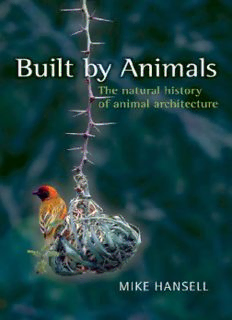
Built by Animals: The Natural History of Animal Architecture PDF
Preview Built by Animals: The Natural History of Animal Architecture
Built by Animals ToGraeme Built by Animals The natural history of animal architecture MIKE HANSELL 1 3 GreatClarendonStreet,OxfordOX26DP OxfordUniversityPressisadepartmentoftheUniversityofOxford. ItfurtherstheUniversity’sobjectiveofexcellenceinresearch,scholarship, andeducationbypublishingworldwidein Oxford NewYork Auckland CapeTown DaresSalaam HongKong Karachi KualaLumpur Madrid Melbourne MexicoCity Nairobi NewDelhi Shanghai Taipei Toronto Withofficesin Argentina Austria Brazil Chile CzechRepublic France Greece Guatemala Hungary Italy Japan Poland Portugal Singapore SouthKorea Switzerland Thailand Turkey Ukraine Vietnam OxfordisaregisteredtrademarkofOxfordUniversityPress intheUKandincertainothercountries PublishedintheUnitedStates byOxfordUniversityPressInc.,NewYork ©MikeHansell2007 Themoralrightsoftheauthorhavebeenasserted DatabaserightOxfordUniversityPress(maker) Firstpublished2007 Allrightsreserved.Nopartofthispublicationmaybereproduced, storedinaretrievalsystem,ortransmitted,inanyformorbyanymeans, withoutthepriorpermissioninwritingofOxfordUniversityPress, orasexpresslypermittedbylaw,orundertermsagreedwiththeappropriate reprographicsrightsorganization.Enquiriesconcerningreproduction outsidethescopeoftheaboveshouldbesenttotheRightsDepartment, OxfordUniversityPress,attheaddressabove Youmustnotcirculatethisbookinanyotherbindingorcover andyoumustimposethesameconditiononanyacquirer BritishLibraryCataloguinginPublicationData Dataavailable LibraryofCongressCataloginginPublicationData Dataavailable TypesetbySPIPublisherServices,Pondicherry,India PrintedinGreatBritain onacid-freepaperby BiddlesLtd.,King’sLynn,Norfolk ISBN 978–0–19–920556–1 1 3 5 7 9 10 8 6 4 2 Contents ListofFigures vi Preface vii 1. TheBuilders 1 2. BuildersChangetheWorld 26 3. YouDon’tNeedBrainstobeaBuilder 58 4. Who’sinChargeRoundHere? 92 5. FromOneNesttoAnother 121 6. TwoRoutesLeadtoTrapBuilding 147 7. TheMagicoftheToolUsers 180 8. BeautifulBowers? 216 NotesandReferences 252 Index 258 v List of Figures 1.1 Brants’whistlingratburrowsystem 16 1.2 Nestoflong-billedspiderhunter 20 1.3 Leafcutterants’nest 23 2.1 Mudshrimpburrow 35 2.2 Magnetictermitenests 44 3.1 Amoebacase 59 3.2 Similarbeaks,dissimilarnests 65 3.3 Beaksindicatefeedinghabits 66 3.4 Oikopleurahouse 70 3.5 Whichspeciesareburrowdiggers? 88 4.1 Virtualwaspnests 118 5.1 Cliffswallownests 124 5.2 Ahistoryofnestbuilding 126 6.1 Araneusspider’sorbweb 151 6.2 Marinewormweb 158 6.3 Aminoacidsinspidersilk 164 6.4 Silkabsorbsenergy 169 7.1 Chimpanzeepassesthetrap-tubetest 194 7.2 Toolusebyacapuchinmonkey 197 7.3 NewCaledoniancrowmakestools 200 8.1 Avenuedisplayofthespottedbowerbird 217 8.2 Goldenbowerbirdonitsbower 221 vi Preface It is a family story, and therefore probably untrue, that when at the age of about six I went missing on my short walk to school, I was eventually found watching a beetle negotiating the gutter. My first natural history enthusiasm was certainly insects. Later, an under- graduate project on the case-building behaviour of caddisfly larvae led to a doctoral thesis on the same subject. By that time I knew morethanmostpeoplewouldwishtoknowaboutcaddislarvalcases. Leaving them completely behind, I spent two years teaching at the University of Khartoum in the Sudan, returning to the UK as an AssistantLecturerattheUniversityofGlasgowin1968.Onarriving there I was asked to give three lectures that probably changed the directionofmycareer. At that time, Glasgow final-year Zoology students were given, apartfromtheirspecialsubjectlectures,aseriesofoccasionallectures calledthe‘ACourse’.Thisinessenceconsistedofahandfulofusaca- demicseachgivingafewlecturesonwhatevertookourfancy.Three lectures on caddis cases seemed excessive, so I decided to go to the other extreme and talk about everything that was built by whatever animal. This, I decided, was not to be a mere parade through the animalkingdombutanattempttomakesomesenseof,anddiscover some pattern in, the behaviour of that miscellaneous bunch of web spinners,house,case,mound,andnestbuilders.ThatiswhatIhave tried to do ever since, and this book is an attempt to explain that biology, the biology of animal architecture and building behaviour, to anyone to whom that sounds appealing. It is a book about who builds,howtheybuildandwhatthosebuildingsdo.Ittouchesupon environmentalimpact,animalintelligence,architecture,engineering vii Preface and building materials, on the organization of workforces, on traps, toolsandart. Writing this book has not been the lonely experience that some authors complain about. I would like to thank all those colleagues and friends who, through their daily interest and encouragement, contributed to its completion. This is my first experience of writ- ing for a non-specialist audience, so I am very grateful to Lorna and Rowland Mitchell who, in the role of general readers, gave me valuable feedback, and to Jacquie Marshall who read and tact- fully commented on the whole text. For specialist biological infor- mation and advice, I would like to thank Martin Burns, Robin Dunbar, Geoff Hancock, Felicity Huntingford, Bob Jeanne, Bill McGrew, Aubrey Manning, Maggie Reilly, John Riddell, Flavio Roces, Douglas Russell and Richard Wrangham. For very helpful information on human architecture, I must thank Jonathan Hale. For an enjoyable adventure to find the church of All Saints, Little Shelford, my thanks to Martha Jennings. Finally, I want to express my enormous appreciation to Graeme Ruxton. His broad interests, his enthusiasm, and his readiness to sit down and discuss points of biology have contributed immeasurably to the development of the finaltext.Hewasnotonlypreparedtoreadeverythingbutalsoread againmyreviseddrafts.Idedicatethisbooktohim. viii 1 The Builders Standing with its back to the Atlantic atop a 90m (nearly 300ft) verticalcliff,atthebaseofwhichtheoceanseethesandfoams,isthe great semi-circular, prehistoric fort of Dun Aengus. The location is theverywesternmostfringeofEurope,theAranIslandsoffthecoast ofIreland.Onthelandwardside,thefort’sprotectionfromattackis man-made.Thehalf-mooninnersanctuaryofthefort(45mor148ft across) is embraced by a drystone rampart reaching over 5m high and nearly 4m thick. Beyond this are a further three irregular semi- circlesofdefensivewallsand,shouldeventheouteronebeoverrun, theattackersmustthennegotiateafieldofmassivelimestoneshards, jagged and stood on end. This is a chevaux-de-frise, a term also used todescribethebarbed-wireenlargementsthatprotectedFirstWorld Wartrenches,butliterally‘horsesofFriesland’,spikedobstaclesused atleastfromtheseventeenthcenturytobreakupcavalrycharges.The age of Dun Aengus is uncertain, although it is probably over 2,000 yearsold:moresurprisingly,westilldonotknowwhatthreatcould have stimulated the building of such formidable defences. Our need forprotectionisnotanydifferentfromthatofotherspecies.Animals havealwayshadenemies,inparticulartheclimate,andotherspecies seekingtopreyuponthem.Wearejustanewcomerspeciesresorting tobuildingtoprotectourselvesinathreateningworldwhichincludes 1
Description: